
A | B | C | D | E | F | G | H | CH | I | J | K | L | M | N | O | P | Q | R | S | T | U | V | W | X | Y | Z | 0 | 1 | 2 | 3 | 4 | 5 | 6 | 7 | 8 | 9
| Part of a series on |
| Economics |
|---|
| Part of a series on |
| Macroeconomics |
|---|
 |
In economics, a market is a composition of systems, institutions, procedures, social relations or infrastructures whereby parties engage in exchange. While parties may exchange goods and services by barter, most markets rely on sellers offering their goods or services (including labour power) to buyers in exchange for money. It can be said that a market is the process by which the prices of goods and services are established. Markets facilitate trade and enable the distribution and allocation of resources in a society. Markets allow any tradeable item to be evaluated and priced. A market emerges more or less spontaneously or may be constructed deliberately by human interaction in order to enable the exchange of rights (cf. ownership) of services and goods. Markets generally supplant gift economies and are often held in place through rules and customs, such as a booth fee, competitive pricing, and source of goods for sale (local produce or stock registration).
Markets can differ by products (goods, services) or factors (labour and capital) sold, product differentiation, place in which exchanges are carried, buyers targeted, duration, selling process, government regulation, taxes, subsidies, minimum wages, price ceilings, legality of exchange, liquidity, intensity of speculation, size, concentration, exchange asymmetry, relative prices, volatility and geographic extension. The geographic boundaries of a market may vary considerably, for example the food market in a single building, the real estate market in a local city, the consumer market in an entire country, or the economy of an international trade bloc where the same rules apply throughout. Markets can also be worldwide, see for example the global diamond trade. National economies can also be classified as developed markets or developing markets.
In mainstream economics, the concept of a market is any structure that allows buyers and sellers to exchange any type of goods, services and information. The exchange of goods or services, with or without money, is a transaction.[1] Market participants or economic agents consist of all the buyers and sellers of a good who influence its price, which is a major topic of study of economics and has given rise to several theories and models concerning the basic market forces of supply and demand. A major topic of debate is how much a given market can be considered to be a "free market", that is free from government intervention. Microeconomics traditionally focuses on the study of market structure and the efficiency of market equilibrium; when the latter (if it exists) is not efficient, then economists say that a market failure has occurred. However, it is not always clear how the allocation of resources can be improved since there is always the possibility of government failure.
Definition
In economics, a market is a coordinating mechanism that uses prices to convey information among economic entities (such as firms, households and individuals) to regulate production and distribution. In his seminal 1937 article "The Nature of the Firm", Ronald Coase wrote: "An economist thinks of the economic system as being coordinated by the price mechanism....in economic theory we find that the allocation of factors of production between different uses is determined by the price mechanism".[2] Thus the usage of the price mechanism to convey information is the defining feature of the market. This is in contrast to a firm, which as Coase put it, "the distinguishing mark of the firm is the super-session of the price mechanism".[2]
Thus, Firms and Markets are two opposite forms of organizing production; Coase wrote:
Outside the firm, price movements direct production, which is co-ordinated through a series of exchange transactions on the market. Within a firm, these market transactions are eliminated and in place of the complicated market structure with exchange transactions is substituted the entrepreneur-co-ordinator, who directs production.[2]
There are also other hybrid forms of coordinating mechanisms, in between the hierarchical firm and price-coordinating market(e.g. global value chains, Business Ventures, Joint Venture, and strategic alliances).
The reasons for the existence of firms or other forms of co-ordinating mechanisms of production and distribution alongside the market are studied in "The Theory of the Firm" literature, with various complete and incomplete contract theories trying to explain the existence of the firm. Incomplete contract theories that are explicitly based on bounded rationality lead to the costs of writing complete contracts. Such theories include: Transaction Cost Economies [3] by Oliver Williamson and Residual Rights Theory[4] by Groomsman, Hart, and Moore.
The market/firm distinction can be contrasted with the relationship between the agents transacting. While in a market the relationship is short term and restricted to the contract, in the case of firms and other co-ordinating mechanisms it is for a longer duration.[5]
In the modern world much economic activity takes place through fiat and not the market. Lafontaine and Slade (2007) estimates, in the US, that the total value added in transactions inside the firms equal the total value added of all market transactions.[6] Similarly, 80% of all World Trade is conducted under Global Value Chains (2012 estimate), while 33% (1996 estimate) is intra-firm trade.[7][8] Nearly 50% of US imports and 30% of exports take place within firms.[9] While Rajan and Zingales (1998) have found that in 43 countries two-thirds of the growth in value added between 1980 and 1990 came from increase in firm size.[10]
Types
A market is one of the many varieties of systems, institutions, procedures, social relations and infrastructures whereby parties engage in exchange. While parties may exchange goods and services by barter, most markets rely on sellers offering their goods or services (including labour) in exchange for money from buyers. It can be said that a market is the process by which the prices of goods and services are established. Markets facilitate trade and enable the distribution and allocation of resources in a society. Markets allow any trade-able item to be evaluated and priced. A market sometimes emerges more or less spontaneously or may be constructed deliberately by human interaction in order to enable the exchange of rights (cf. ownership) of services and goods.
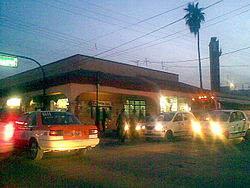
Markets of varying types can spontaneously arise whenever a party has interest in a good or service that some other party can provide. Hence there can be a market for cigarettes in correctional facilities, another for chewing gum in a playground, and yet another for contracts for the future delivery of a commodity. There can be black markets, where a good is exchanged illegally, for example markets for goods under a command economy despite pressure to repress them and virtual markets, such as eBay, in which buyers and sellers do not physically interact during negotiation. A market can be organized as an auction, as a private electronic market, as a commodity wholesale market, as a shopping center, as complex institutions such as international markets and as an informal discussion between two individuals.
Markets vary in form, scale (volume and geographic reach), location and types of participants as well as the types of goods and services traded. The following is a non exhaustive list:
Physical consumer markets

- Food retail markets: farmers' markets, fish markets, wet markets and grocery stores
- Retail marketplaces: public markets, market squares, Main Streets, High Streets, bazaars, souqs, night markets, shopping strip malls and shopping malls
- Big-box stores: supermarkets, hypermarkets and discount stores
- Ad hoc auction markets: process of buying and selling goods or services by offering them up for bid, taking bids and then selling the item to the highest bidder
- Used goods markets such as flea markets
- Temporary markets such as fairs
- Real estate markets
Physical business markets
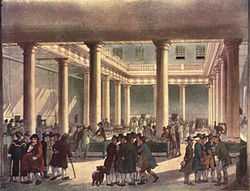
- Physical wholesale markets: sale of goods or merchandise to retailers; to industrial, commercial, institutional, or other professional business users or to other wholesalers and related subordinated services
- Markets for intermediate goods used in production of other goods and services
- Labour markets: where people sell their labour to businesses in exchange for a wage
- Online auctions and Ad hoc auction markets: process of buying and selling goods or services by offering them up for bid, taking bids and then selling the item to the highest bidder
- Temporary markets such as trade fairs
- Energy markets
Non-physical markets
- Media markets (broadcast market): is a region where the population can receive the same (or similar) television and radio station offerings and may also include other types of media including newspapers and Internet content
- Internet markets (electronic commerce): trading in products or services using computer networks, such as the Internet
- Artificial markets created by regulation to exchange rights for derivatives that have been designed to ameliorate externalities, such as pollution permits (see carbon trading)
Financial markets

Financial markets facilitate the exchange of liquid assets. Most investors prefer investing in two markets:
- The stock markets, for the exchange of shares in corporations (NYSE, AMEX and the NASDAQ are the most common stock markets in the United States)
- The bond markets
There are also:
- Currency markets are used to trade one currency for another, and are often used for speculation on currency exchange rates
- The money market is the name for the global market for lending and borrowing
- Futures markets, where contracts are exchanged regarding the future delivery of goods
- Prediction markets are a type of speculative market in which the goods exchanged are futures on the occurrence of certain events; they apply the market dynamics to facilitate information aggregation
- Insurance markets
- Debt markets
Unauthorized and illegal markets
- Grey markets (parallel markets): is the trade of a commodity through distribution channels which, while legal, are unofficial, unauthorized, or unintended by the original manufacturer[citation needed]
- markets in illegal goods such as the market for illicit drugs, illegal arms, infringing products, cigarettes sold to minors or untaxed cigarettes (in some jurisdictions), or the private sale of unpasteurized goat milk[11]
Mechanisms
In economics, a market that runs under laissez-faire policies is called a free market, it is "free" from the government, in the sense that the government makes no attempt to intervene through taxes, subsidies, minimum wages, price ceilings and so on. However, market prices may be distorted by a seller or sellers with monopoly power, or a buyer with monopsony power. Such price distortions can have an adverse effect on market participant's welfare and reduce the efficiency of market outcomes. The relative level of organization and negotiating power of buyers and sellers also markedly affects the functioning of the market.

Markets are a system and systems have structure. The structure of a well-functioning market is defined by the theory of perfect competition. Well-functioning markets of the real world are never perfect, but basic structural characteristics can be approximated for real world markets, for example:
- Many small buyers and sellers
- Buyers and sellers have equal access to information
- Products are comparable
Markets where price negotiations meet equilibrium, but the equilibrium is not efficient are said to experience market failure. Market failures are often associated with time-inconsistent preferences, information asymmetries, non-perfectly competitive markets, principal–agent problems, externalities, or public goods. Among the major negative externalities which can occur as a side effect of production and market exchange, are air pollution (side-effect of manufacturing and logistics) and environmental degradation (side-effect of farming and urbanization).
There exists a popular thought, especially among economists, that free markets would have a structure of a perfect competition.[citation needed] The logic behind this thought is that market failure is thought to be caused by other exogenic systems, and after removing those exogenic systems ("freeing" the markets) the free markets could run without market failures.[citation needed] For a market to be competitive, there must be more than a single buyer or seller. It has been suggested that two people may trade, but it takes at least three persons to have a market so that there is competition in at least one of its two sides.[12] However, competitive markets—as understood in formal economic theory—rely on much larger numbers of both buyers and sellers. A market with a single seller and multiple buyers is a monopoly. A market with a single buyer and multiple sellers is a monopsony. These are "the polar opposites of perfect competition".[13] As an argument against such logic, there is a second view that suggests that the source of market failures is inside the market system itself, therefore the removal of other interfering systems would not result in markets with a structure of perfect competition. As an analogy, such an argument may suggest that capitalists do not want to enhance the structure of markets, just like a coach of a football team would influence the referees or would break the rules if he could while he is pursuing his target of winning the game. Thus, according to this view, capitalists are not enhancing the balance of their team versus the team of consumer-workers, so the market system needs a "referee" from outside that balances the game. In this second framework, the role of a "referee" of the market system is usually to be given to a democratic government.
Research

Disciplines such as sociology, economic history, economic geography and marketing developed novel understandings of markets[14] studying actual existing markets made up of persons interacting in diverse ways in contrast to an abstract and all-encompassing concepts of "the market". The term "the market" is generally used in two ways:
- "The market" denotes the abstract mechanisms whereby supply and demand confront each other and deals are made; in its place, reference to markets reflects ordinary experience and the places, processes and institutions in which exchanges occurs[15]
- "The market" signifies an integrated, all-encompassing and cohesive capitalist world economy.
Economics
Political economy
Economics used to be called political economy, as Adam Smith defined it in The Wealth of Nations:[16]
Political economy, considered as a branch of the science of a statesman or legislator, proposes two distinct objects; first, to provide a plentiful revenue or subsistence for the people, or, more properly, to enable them to provide such a revenue or subsistence for themselves; and, secondly, to supply the state or commonwealth with a revenue sufficient for the public services. It proposes to enrich both the people and the sovereign.

The earliest works of political economy are usually attributed to United Kingdom scholars Adam Smith, Thomas Malthus, and David Ricardo, although they were preceded by the work of the French physiocrats, such as François Quesnay (1694–1774) and Anne-Robert-Jacques Turgot (1727–1781). Smith describes how exchange of goods arose:[17]
"As it is by treaty, by barter, and by purchase, that we obtain from one another the greater part of those mutual good offices which we stand in need of, so it is this same trucking disposition which originally gives occasion to the division of labour. In a tribe of hunters or shepherds, a particular person makes bows and arrows, for example, with more readiness and dexterity than any other. He frequently exchanges them for cattle or for venison, with his companions; and he finds at last that he can, in this manner, get more cattle and venison, than if he himself went to the field to catch them. From a regard to his own interest, therefore, the making of bows and arrows grows to be his chief business, and he becomes a sort of armourer. Another excels in making the frames and covers of their little huts or moveable houses. He is accustomed to be of use in this way to his neighbours, who reward him in the same manner with cattle and with venison, till at last he finds it his interest to dedicate himself entirely to this employment, and to become a sort of house-carpenter. In the same manner a third becomes a smith or a brazier; a fourth, a tanner or dresser of hides or skins, the principal part of the clothing of savages. And thus the certainty of being able to exchange all that surplus part of the produce of his own labour, which is over and above his own consumption, for such parts of the produce of other men's labour as he may have occasion for, encourages every man to apply himself to a particular occupation, and to cultivate and bring to perfection whatever talent of genius he may possess for that particular species of business."

And explains how exchanged mediated by money came to dominate the market:[18]
"But when barter ceases, and money has become the common instrument of commerce, every particular commodity is more frequently exchanged for money than for any other commodity. The butcher seldom carries his beef or his mutton to the baker or the brewer, in order to exchange them for bread or for beer; but he carries them to the market, where he exchanges them for money, and afterwards exchanges that money for bread and for beer. The quantity of money which he gets for them regulates, too, the quantity of bread and beer which he can afterwards purchase. It is more natural and obvious to him, therefore, to estimate their value by the quantity of money, the commodity for which he immediately exchanges them, than by that of bread and beer, the commodities for which he can exchange them only by the intervention of another commodity; and rather to say that his butcher's meat is worth three-pence or fourpence a-pound, than that it is worth three or four pounds of bread, or three or four quarts of small beer. Hence it comes to pass, that the exchangeable value of every commodity is more frequently estimated by the quantity of money, than by the quantity either of labour or of any other commodity which can be had in exchange for it."
Microeconomics
Microeconomics (from Greek prefix mikro- meaning "small" and economics) is a branch of economics that studies the behavior of individuals and small impacting organizations in making decisions on the allocation of limited resources (see scarcity). On the other hand, macroeconomics (from the Greek prefix makro- meaning "large" and economics) is a branch of economics dealing with the performance, structure, behavior and decision-making of an economy as a whole, rather than individual markets.
Marginal revolution
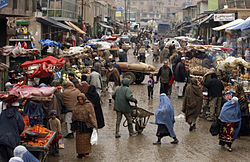
The modern field of microeconomics arose as an effort of neoclassical economics school of thought to put economic ideas into mathematical mode. It began in the 19th century debates surrounding the works of Antoine Augustin Cournot, William Stanley Jevons, Carl Menger and Léon Walras—this period is usually denominated as the Marginal Revolution. A recurring theme of these debates was the contrast between the labor theory of value and the subjective theory of value, the former being associated with classical economists such as Adam Smith, David Ricardo and Karl Marx (Marx was a contemporary of the marginalists). A labour theory of value can be understood as a theory that argues that economic value is determined by the amount of socially necessary labour time while a subjective theory of value derives economic value from subjective preferences, usually by specifying a utility function in accordance with utilitarian philosophy.
In his Principles of Economics (1890),[19] Alfred Marshall presented a possible solution to this problem, using the supply and demand model. Marshall's idea of solving the controversy was that the demand curve could be derived by aggregating individual consumer demand curves, which were themselves based on the consumer problem of maximizing utility. The supply curve could be derived by superimposing a representative firm supply curves for the factors of production and then market equilibrium (economic equivalent of mechanical equilibrium) would be given by the intersection of demand and supply curves. He also introduced the notion of different market periods: mainly long run and short run. This set of ideas gave way to what economists call perfect competition—now found in the standard microeconomics texts, even though Marshall himself was highly skeptical it could be used as general model of all markets.
Market structure
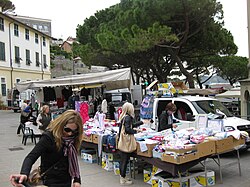

Opposed to the model of perfect competition, some models of imperfect competition were proposed:
- The monopoly model, already considered by marginalist economists, describes a profit maximizing capitalist facing a market demand curve with no competitors, who may practice price discrimination.
- Oligopoly is a market form in which a market or industry is dominated by a small number of sellers. The oldest model was the spring water duopoly of Cournot (1838) [20] in which equilibrium is determined by the duopolists reactions functions. It was criticized by Harold Hotelling for its instability, by Joseph Bertrand for lacking equilibrium for prices as independent variables.
- Monopolistic competition is a type of imperfect competition such that many producers sell products that are differentiated from one another (e.g., by branding or quality) and hence are not perfect substitutes. In monopolistic competition, a firm takes the prices charged by its rivals as given and ignores the impact of its own prices on the prices of other firms. The "founding father" of the theory of monopolistic competition is Edward Hastings Chamberlin, who wrote a pioneering book on the subject, Theory of Monopolistic Competition (1933). Joan Robinson published a book called The Economics of Imperfect Competition with a comparable theme of distinguishing perfect from imperfect competition. Chamberlin defined monopolistic competition as "challenge to traditional viewpoint of economics that competition and monopoly are alternatives and that individual prices are to be explained in terms of one or the other". He continues: "By contrast it is held that most economic situations are composite of both competition and monopoly, and that, wherever this is the case, a false view is given by neglecting either one of the two forces and regarding the situation as made up entirely of the other".[21] Hotelling built a model of market located over a line with two sellers in each extreme of the line, in this case maximizing profit for both sellers leads to a stable equilibrium. From this model also follows that if a seller is to choose the location of his store so as to maximize his profit, he will place his store the closest to his competitor as "the sharper competition with his rival is offset by the greater number of buyers he has an advantage".[22] He also argues that clustering of stores is wasteful from the point of view of transportation costs and that public interest would dictate more spatial dispersion.
- William Baumol provided in his 1977 paper[23] the current formal definition of a natural monopoly where "an industry in which multifirm production is more costly than production by a monopoly".
- Baumol defined a contestable market in his 1982 paper[24] as a market where "entry is absolutely free and exit absolutely costless", freedom of entry in Stigler sense: the incumbent has no cost discrimination against entrants. He states that a contestable market will never have an economic profit greater than zero when in equilibrium and the equilibrium will also be efficient. According to Baumol, this equilibrium emerges endogenously due to the nature of contestable markets; that is, the only industry structure that survives in the long run is the one which minimizes total costs. This is in contrast to the older theory of industry structure since not only is industry structure not exogenously given, but equilibrium is reached without an ad hoc hypothesis on the behavior of firms, say using reaction functions in a duopoly. He concludes the paper commenting that regulators that seek to impede entry and/or exit of firms would do better to not interfere if the market in question resembles a contestable market.
Market failure

Around the 1970s the study of market failures came into focus with the study of information asymmetry. In particular, three authors emerged from this period: Akerlof, Spence and Stiglitz. Akerlof considered the problem of bad quality cars driving good quality cars out of the market in his classic "The Market for Lemons" (1970) because of the presence of asymmetrical information between buyers and sellers.[25] Michael Spence explained that signaling was fundamental in the labour market since employers cannot know beforehand which candidate is the most productive, a college degree becomes a signaling device that a firm uses to select new personnel.[26] Stiglitz provided some general conditions under which market equilibrium is not efficient: presence of externalities, imperfect information and incomplete markets.[27]
State interference
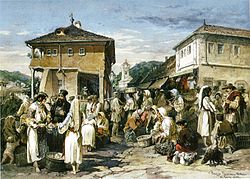
György Lukács, a founder of Western Marxism wrote about the essence of commodity-structure:.[28]
Before tackling the problem itself we must be quite clear in our minds that commodity fetishism is a specific problem of our age, the age of modern capitalism. Commodity exchange and the corresponding subjective and objective commodity relations existed, as we know, when society was still very primitive. What is at issue here, however, is the question: how far is commodity exchange together with its structural consequences able to influence the total outer and inner life of society? Thus the extent to which such exchange is the dominant form of metabolic change in a society cannot simply be treated in quantitative terms—as would harmonize with the modern modes of thought already eroded by the reifying effects of the dominant commodity form. The distinction between a society where this form is dominant, permeating every expression of life, and a society where it only makes an episodic appearance is essentially one of quality. For depending on which is the case, all the subjective phenomena in the societies concerned are objectified in qualitatively different ways.
Human labour is abstracted and incorporated in commodities:[29]
- Objectively: is so far as the commodity form facilitates the equal exchange of qualitatively different things
- Subjectively: human labour is both the common factor to which all commodities are reduced (in the abstract) and the principle governing the actual production of commodities (in reality)
The ultimate problem for the thought of the bourgeoisie is the crisis: the qualitative existence of the 'things' misunderstood as use-values become the decisive factor. The failure is characteristic of classical economics and bourgeoisie economics, inadequate at explaining the true movement of economic activity in toto. The state has a system of law corresponding to capitalist needs: bureaucracy, formal standardization of justice and civil service.[28]
C. B. Macpherson identifies an underlying model of the market underlying Anglo-American liberal democratic political economy and philosophy in the seventeenth and eighteenth centuries: persons are cast as self-interested individuals, who enter into contractual relations with other such individuals, concerning the exchange of goods or personal capacities cast as commodities, with the motive of maximizing pecuniary interest. The state and its governance systems are cast as outside of this framework.[30] This model came to dominant economic thinking in the later nineteenth century, as so called liberal economists such as Ricardo, Mill, Jevons, Walras and later neo-classical economics shifted from reference to geographically located marketplaces to an abstract "market".[31] This tradition is continued in contemporary neoliberalism epitomised by the Mont Pelerin Society which gathered Frederick Hayek, Ludwig von Mises, Milton Friedman and Karl Popper, where the market is held up as optimal for wealth creation and human freedom and the states' role imagined as minimal, reduced to that of upholding and keeping stable property rights, contract and money supply. According to David Harvey, this allowed for boilerplate economic and institutional restructuring under structural adjustment and post-Communist reconstruction.[32] Similar formalism occurs in a wide variety of social democratic and Marxist discourses that situate political action as antagonistic to the market.
A central theme of empirical analyses is the variation and proliferation of types of markets since the rise of capitalism and global scale economies. The Regulation school stresses the ways in which developed capitalist countries have implemented varying degrees and types of environmental, economic and social regulation, taxation and public spending, fiscal policy and government provisioning of goods, all of which have transformed markets in uneven and geographical varied ways and created a variety of mixed economies.
Economic coordination
Drawing on concepts of institutional variance and path dependence, varieties of capitalism theorists (such as Peter Hall and David Soskice) identify two dominant modes of economic ordering in the developed capitalist countries:
- Coordinated market economies (such as Germany and Japan) based on relational or incomplete contracting, network monitoring based on the exchange of private information inside networks, and more reliance on collaborative, as opposed to competitive, relationships to build the competencies of the firm
- Anglo-American liberal market economies: firms coordinate their activities primarily via hierarchies and competitive market arrangements.

However, such approaches imply that the Anglo-American liberal market economies in fact operate in a matter close to the abstract notion of "the market". While Anglo-American countries have seen increasing introduction of neo-liberal forms of economic ordering, this has not led to simple convergence, but rather a variety of hybrid institutional orderings.[33] Rather, a variety of new markets have emerged, such as for carbon trading or rights to pollute. In some cases, such as emerging markets for water in England and Wales, different forms of neoliberalism have been tried: moving from the state hydraulic model associated with concepts of universal provision and public service to market environmentalism associated with pricing of environmental externalities to reduce environmental degradation and efficient allocation of water resources. In this case liberalization has multiple meanings:
- Privatization: change of ownership from state monopoly to private hands
- Commercialization: pursuing efficiency, cost-benefit analysis and profit maximization by introducing prices in comparison with the bill system proportional to property value
- Commodification: standardization, pricing to address water scarcity according to the Dublin principles and the Hague declaration
In a period of fiscal and ideological crisis, state failure is seen as the catalyst for liberalization, however the failure in assuring water quality can be seen as a driver for economic and ecological reregulation (in this case coming from the European Union). More broadly the idea of a water market failure can be seen as the explanation for state intervention, generating a natural monopoly of hydraulic infrastructure and the regulation of externalities such as water pollution. The situation however is not that simple, as the regulator may have the duty of introducing competition, which can be:
- Direct competition or product competition
- Surrogate competition
- Competition for corporate control by mergers and takeovers
- Procurement competition
- Franchising
Introduction of metering can result in both restriction and increase of consumption with LRMC pricing being the regulator (Ofwat) preferred methodology.[34]
Marketing
Market distribution

Paul Dulaney Converse and Fred M. Jones wrote:[35]
Market distribution includes those activities which create place, time, and possession utilities. To the economist, market distribution is therefore part of production because it deals with the creation of utilities, and "distribution" refers to the distribution of wealth among the members of society. The businessman, however, thinks of distribution as selling his goods and getting them into the hands of the consumer. To the businessman, "distribution" means marketing—selling and transportation.
The methods of studying marketing are:
- Functional approach: services or functions performed, what goods they are performed upon, what middlemen perform them
- Commodity approach: what goods are marketed, what function are performed on them, what middlemen perform these functions
- Institutional approach: what institutions, or middlemen, are engaged in distribution, what functions they perform, what good they handle

Businesses market their products/services to a specific segments of consumers: the defining factors of the markets are determined by demographics, interests and age/gender. A small market is a niche market, while a big market is a mass market. A form of expansion is to enter a new market and sell/advertise to a different set of users.
Marketing management
The marketing management school, evolved in the late 1950s and early 1960s, is fundamentally linked with the marketing mix[36] framework, a business tool used in marketing and by marketers. In his paper "The Concept of the Marketing Mix", Neil H. Borden reconstructed the history of the term "marketing mix".[37][38] He started teaching the term after an associate, James Culliton, described the role of the marketing manager in 1948 as a "mixer of ingredients"; one who sometimes follows recipes prepared by others, sometimes prepares his own recipe as he goes along, sometimes adapts a recipe from immediately available ingredients, and at other times invents new ingredients no one else has tried. The functions of total marketing include advertising, personal selling, packaging, pricing, channeling and warehousing. Borden also identified the market forces affecting marketing mix:
- Consumer buying behavior
- Trade's behavior (wholesale and retailing)
- Competitors position and behavior: industry structure, product choice, oversupply, pricing and innovation
- Governmental behavior: regulations
Borden concludes saying that marketing is more an art than a science. The marketer E. Jerome McCarthy proposed a four Ps classification (product, price, promotion, place) in 1960, which has since been used by marketers throughout the world.[39] Koichi Shimizu proposed a 7Cs Compass Model (corporation, commodity, cost, communication, channel, consumer, circumstances) to provide a more complete picture of the nature of marketing in 1981. Robert F. Lauterborn wrote about the Four P's in 1990[40]
When Jerry McCarthy and Phil Kotler proposed their alliterative litany – Product, Price, Place and Promotion – the marketing world was very different. Roaring out of World War II with a cranked-up production system ready to feed a lust for better living, American business linked management science to the art of mass marketing and rocketed to the moon. In the days of "Father Knows Best," it all seemed so simple. The advertiser developed a product, priced it to make a profit, placed it on the retail shelf and promoted it to a pliant, even eager consumer. Mass media simultaneously taught consumptive culture and provided advertisers with efficient access to an audience which would behave, Dr. Dichter assured us, perfectly predictably, given the proper stimulation.
He instead advocated a four Cs classification which is a more consumer-oriented version of the four Ps that attempts to better fit the movement from mass marketing to niche marketing:
- Consumer: do not focus on product, study consumer wants and needs
- Cost: forget price, instead understand the consumer cost to satisfy that want or need, even driving time versus time spent with family matters
- Communication: forget promotion, instead focus on communication and create dialogue
- Convenience: forget place, instead think about convenience to buy, know each market subsegment
Sociology
Economic rationality
Max Weber defines the measure of rational economic action as the:[41]
- Systematic distribution of utilities between present and future
- Systematic distribution of utilities between various potential uses
- Systematic production of utilities by manufacture or transportation by the owner of the means of production
- Systematic acquisition by agreement of the powers of control and disposal over utilities, mainly by establishing corporate groups or by exchange

Opposition of interests is typically resolved by bargaining or by competitive biding:
Zdroj:https://en.wikipedia.org?pojem=Market_(economics)Text je dostupný za podmienok Creative Commons Attribution/Share-Alike License 3.0 Unported; prípadne za ďalších podmienok. Podrobnejšie informácie nájdete na stránke Podmienky použitia.
Antropológia
Aplikované vedy
Bibliometria
Dejiny vedy
Encyklopédie
Filozofia vedy
Forenzné vedy
Humanitné vedy
Knižničná veda
Kryogenika
Kryptológia
Kulturológia
Literárna veda
Medzidisciplinárne oblasti
Metódy kvantitatívnej analýzy
Metavedy
Metodika
Text je dostupný za podmienok Creative
Commons Attribution/Share-Alike License 3.0 Unported; prípadne za ďalších
podmienok.
Podrobnejšie informácie nájdete na stránke Podmienky
použitia.
www.astronomia.sk | www.biologia.sk | www.botanika.sk | www.dejiny.sk | www.economy.sk | www.elektrotechnika.sk | www.estetika.sk | www.farmakologia.sk | www.filozofia.sk | Fyzika | www.futurologia.sk | www.genetika.sk | www.chemia.sk | www.lingvistika.sk | www.politologia.sk | www.psychologia.sk | www.sexuologia.sk | www.sociologia.sk | www.veda.sk I www.zoologia.sk
